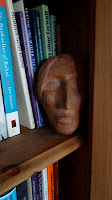A few days ago I was talking to another potter about RED glaze (which is notoriously hard to get) and that I had mixed up a glaze recipe described as tin red which turned brown during firing. She'd read that the ingredient chromium oxide which is to produce the red fails to perform if the temperature is too high.
So I did another firing reducing the top temperature from 1260 degrees to 1240. The results were interesting:
 |
| Left hand cup: red glaze under cream. Right hand cup: red glaze over cream. |
Towards the bottom of the kiln, the insides of two teacups turned kind of raspberry whilst the outsides stayed mainly cream (the other glaze colour I'd applied) even though the tin red glaze had been equally applied to half the insides and outsides of the cups.
Towards the top of the kiln, the tin red glaze applied to the outside of the pictured bowl continued to fire to a brown finish.
 |
| Cream glaze inside bowl and on outside rim. Tin red glaze on lower outside. |
So what went on? Did the red inside the teacups in the lower part of the kiln come about because the temperature was lower? That seems to make sense.
But why is there only a hint of red on the outsides of the teacups? Did greater airflow around them interfere with the performance of the chromium oxide?
Did the bowl that turned brown in the top half of the kiln do so because it was hotter up there? Were the firing conditions towards the top of the kiln more like those during the previous firing which only yielded brown results? I wished I knew the answers!
Whilst I continue to scratch my head, I am rather chuffed with the colour I've managed to get. Fingers crossed, I can do it again!!!












